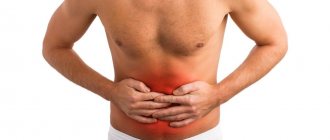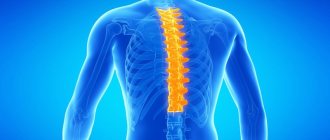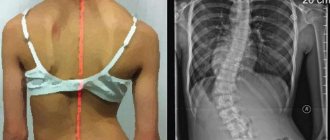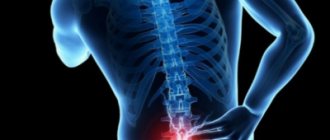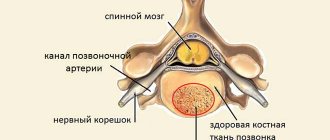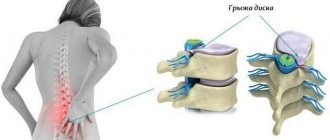Let's imagine a typical picture: young women are sitting at their workplaces in an office at computers. Suddenly one of them begins to feel uneasy: unexpected dizziness appears, severe nausea, and vomiting begins. Colleagues quickly come to the rescue: they serve a glass of water, open a window for fresh air. When a woman gets better, a joke question is heard: is she going on maternity leave? What would you say if similar symptoms occurred in a man?
Nausea and dizziness are a sign of various diseases, and the person’s further well-being will depend on how correctly the diagnosis is made. Someone will be surprised to learn that nausea is a symptom of osteochondrosis.
Can you feel sick with osteochondrosis? Yes, although this symptom does not appear as often as, for example, headache, numbness of the limbs, signs of a sore throat or tinnitus. Nausea with osteochondrosis of the cervical spine affects both women and men. But, like the strong half of our society, they rarely talk about this.
Can you feel nauseous with SHOH?
The feeling of nausea occurs unexpectedly. Often people attribute it to overwork or general malaise. However, this pathological condition indicates the development of cervical osteochondrosis. The neck area contains a large number of blood vessels and nerves. Under heavy stress, arteries or nerve endings are compressed .
With slight compression of the arteries, headaches and dizziness are observed. Nausea occurs with a progressive form of the pathological process.
Why do nausea and headaches occur with cervical osteochondrosis?
With cervical osteochondrosis, nausea and headaches can occur for various reasons. The first reason why these unpleasant symptoms develop is the lack of blood supply to the cerebral structures of the brain. It is worth understanding the mechanism of development of this pathology:
- with cervical osteochondrosis, deformation of the holes through which the posterior vertebral arteries pass occurs;
- instability of the position of intervertebral discs affected by degeneration leads to the fact that at certain moments a disruption of cerebral blood supply occurs;
- when there is a shortage of arterial blood supply to the posterior structures of the brain, a compensatory reaction mechanism is triggered in the form of narrowing of the arteries;
- this leads to a sharp increase in blood pressure levels;
- dizziness and nausea appear due to the release of cortisol, vasopressin and other hormones into the blood that increase blood pressure levels.
If all these measures of the body's complex response do not lead to an increase in blood flow to the posterior structures of the brain, then vomiting and loss of consciousness may occur. Long-term disruption of cerebral circulation can lead to the development of a full-fledged ischemic stroke. This is one of the most dangerous complications of cervical osteochondrosis. As a result of an acute cerebrovascular accident (stroke), a person loses his ability to work and becomes virtually disabled.
Degeneration of cartilage tissue occurs in the collar area, between the 5th, 6th and 7th vertebrae. Here the radicular nerves depart, which form a network for the innervation of the organs of the upper abdominal cavity. This is where the vagus nerve originates.
With osteochondrosis of the spine in this part, the nausea may not be cerebral, but functional, provoked by factors such as:
- stagnation of bile in the cavity of the gallbladder, liver ducts and duodenal duct;
- disruption of the outflow of bile juice from the pancreas due to a decrease or increase in the tone of the muscle wall of the common bile duct;
- spasm of the stomach and loss of its ability to quickly evacuate the food bolus;
- damage to the gastric valves;
- reduction in the efficiency of the diaphragm.
All these conditions may be associated with disruption of the innervation process.
The third provocative factor is the development of neurosis of the pharynx and larynx. This condition often accompanies cervical osteochondrosis. Attacks of nausea are associated with the fact that the mucous membrane in the area where the so-called gag reflex is present is irritated. This is the area of the root of the tongue. With laryngeal neurosis, this part suffers from swelling. Therefore, the patient may experience bouts of nausea and even vomiting.
Why is this happening?
Nausea occurs due to the fact that the formed hernia compresses the artery that supplies the brain. As a result, the organ does not receive enough oxygen and nutrients. Against the background of such a deviation, a feeling of nausea arises. It intensifies in the morning or when turning the head.
Due to increased blood pressure, the patient may begin to vomit. To establish a connection between nausea and cervical osteochondrosis, the doctor conducts a diagnosis, since this symptom may indicate other dangerous diseases.
Diet for dizziness
If you have osteochondrosis with dizziness, appropriate nutrition and compliance with a few simple rules will help you feel better:
- Salt-free diet – because salt retains water in the body, and this overloads the veins, they do not have time to deliver waste products to the excretory organs, and slagging of blood vessels and joints occurs.
- Avoid sweet, starchy foods, coffee and strong tea.
- Avoid smoked meats and pickles.
- Drink no more than 1.5 liters of liquid per day.
- Increase the consumption of fermented milk products, vegetables, and fruits.
- Jellied meats and jelly should be on the table as often as possible, because... they restore cartilage tissue of joints and vertebrae.
The symptom of dizziness with osteochondrosis is an unpleasant symptom. This is a signal that the body requires help to fight the disease. And this assistance must be provided in a timely manner.
Diagnostics
If nausea and other symptoms of osteochondrosis of the cervical spine appear, you should consult a doctor. Before making a diagnosis, he checks the patient's posture, asymmetry of the shoulder blades and the contours of the cervical vertebrae. During the examination, the doctor determines the location of pain points.
Based on the data obtained, the specialist makes a preliminary diagnosis and prescribes a series of examinations to confirm it. The following is scheduled :
- MRI;
- radiography;
- computed tomography.
If necessary, the doctor performs Doppler ultrasound of the arteries of the brain. Self-diagnosis and treatment of the disease can only worsen the situation.
Associated symptoms
In addition to nausea, with degenerative lesions of the cervical spine, a number of other symptoms occur. Most often this is:
- headache;
- vomiting in the morning;
- dizziness.
In some cases, increased body temperature is observed.
Headache
Initially, pain occurs in the neck area; as osteochondrosis develops, the pain moves to the head area. She has a dull and constant character. Most often, unpleasant sensations are present in the back of the head.
Less commonly, pain may be felt in the area:
- temples;
- forehead;
- ears;
- tops of heads.
First, the pain syndrome occurs in one part of the head, and suddenly moves to another.
If you stay in one position for a long time or make sudden movements, the headache may get worse. Sometimes the patient feels discomfort if you put a little pressure on the neck near the base of the skull.
Vomiting in the morning
Bouts of vomiting in the morning occur against the background of high blood pressure. Along with vomiting, pain in the heart area may occur. In this case, you should immediately consult a doctor.
Dizziness
Dizziness can occur at any time of the day. Most often, the patient feels this discomfort in the morning, after sleeping on a high pillow.
Attacks can last from a few minutes to a couple of hours. This causes hearing loss and tinnitus.
Temperature
Temperature with cervical osteochondrosis may indicate the development of vertebral artery syndrome. The connecting elements are pinched, and this leads to disruption of normal blood flow . Against the background of such changes, disturbances in the functioning of the vestibular apparatus and psychoneurotic disorders occur. The inflammatory process begins, which leads to an increase in the patient’s body temperature.
Prevention
- Exercise regularly.
- Don't let the disease take its course.
- Sleep stretched out on your side.
- While sitting, lean your back against the back of the chair.
- Take a steam bath from time to time, after consulting with your doctor
- When working at the computer, keep your shoulders in a natural position.
- Keep a positive attitude.
It would be a mistake to wait until problems of nausea and dizziness arise and then take the necessary measures. The disease can develop so seriously that you have to take sick leave for treatment. If you think about it seriously, then most of the pain and discomfort can be avoided, as well as save a decent part of the budget.
How to get rid of it?
To get rid of nausea with cervical osteochondrosis, it is necessary to eliminate the root cause of this condition. There are a number of ways that can help temporarily improve the patient's well-being.
Eliminate the root cause
The cause of nausea is oxygen starvation of the brain. To restore normal health, you need to eliminate it:
- It is recommended to go outside or stand near an open window.
- You should unbutton your collar and take active breaths.
First aid
If the attack of nausea is mild, then the patient can provide first aid to himself. To do this you need to do a simple exercise:
- You need to sit down on a hard and flat surface.
- Cross your arms and take a breath. In this case, the torso must be tilted to the left; at the exit, the patient must straighten up.
- A similar movement is made in the second direction.
An equally effective exercise is pressing your palm on your forehead for 11 seconds . Do 4 repetitions at intervals of 5-10 seconds.
Symptoms
Sometimes with cervical osteochondrosis there are no symptoms.
The first major sign of neck disease is headache. The intensity and location of the source of pain depends on the severity of the disease. It can be shooting, sharp, aching. Localized in the forehead and back of the head. The pain intensifies in the evening. The general manifestations of the disease are severe. The neck hurts and unpleasant sensations are transmitted to the jaw, throat, and chest. The covering of the body becomes very sensitive - light touches cause irritation and pain. In exceptional cases, the skin may be red and inflamed.
Feeling dizzy due to pressure on the blood vessels that supply the central nervous system. Occurs with a sharp rise or turn of the head. Headaches and fever rise.
Lack of normal vision, in which spots flash before the eyes, noise in the ears, possible weakness, loss of consciousness, nausea, vomiting - this can occur with osteochondrosis. When a person feels sick or vomits, but the symptoms do not stop after vomiting, you should consult a doctor.
Nausea can cause stomach discomfort. The listed symptoms appear with VSD. Dizziness, nausea, stomach pain, diarrhea, and weakness are characteristic of poisoning. Symptoms of weakness, impotence, nagging pain in the neck, headache may be signs of other spinal disorders.
With osteochondrosis, there is aching, pulling, and aching in the lower back. Thoracic osteochondrosis is manifested by pain in the chest and sternal spine.
Osteochondrosis of a certain localization is characterized by specific symptoms. There are especially many of them in cervical pathology. This is a decrease in visual acuity and hearing, a sudden attack of arterial hypertension, shortness of breath, a dry (sometimes wet) cough, a feeling of lack of air, soreness and a “coma” in the throat. Nausea and dizziness are accompanied by headaches similar to migraines, the appearance of colored spots, circles before the eyes, and double vision.
The thoracic lesion of the intervertebral discs is specifically manifested:
- feeling of tightness in the chest;
- rapid heartbeat - tachycardia, bradycardia;
- pain in the cardiac region, reminiscent of an angina attack;
- excessive sweating;
- bloating, periodic epigastric pain, peristalsis disorders.
Nausea with lumbosacral osteochondrosis occurs extremely rarely, usually due to fear, psycho-emotional instability with frequent “lumbago” in the lower back. In addition to neurogenic symptoms, osteochondrosis is manifested by pain in the area of disc damage, stiffness, and deliberate limitation of movement.
Treatment
Treatment of cervical osteochondrosis should be comprehensive. The doctor prescribes medication, physical therapy and a massage course. Self-massage gives a good effect.
Taking medications
To stop an attack of nausea, the doctor prescribes neurometabolic stimulants. They allow you to activate normal blood circulation in the vessels of the brain.
In most cases, the following drugs are prescribed:
- Aminalon;
- Noofen;
- Afobazole;
- Picamilon.
In some cases, Latran and Cerucal are prescribed . However, such medications are contraindicated for pregnant women and women during breastfeeding.
If you have severe nausea and risk of vomiting, you can take Cerucal or Osetron. These medications should be used as an emergency treatment. To finally get rid of nausea, it is necessary to cure cervical osteochondrosis.
Physiotherapy
Therapeutic exercise has a positive effect on the entire body. It will help not only eliminate nausea, but also relieve pain. The therapeutic complex involves performing a series of head movements and isometric exercises for the neck.
Gymnastics is an important part of the treatment of cervical osteochondrosis . The exercises must be performed smoothly and slowly. Simple and effective steps:
- smooth turns of the head;
- chin extension;
- lowering the head down;
- raising your shoulders up.
Training should be abandoned during periods of exacerbation. To get the maximum therapeutic effect, gymnastics should be combined with massage or self-massage.
Massage and self-massage
Massage will help relieve tension, thereby improving blood circulation. To improve the patient’s condition, it is enough to perform a light massage or self-massage:
- You should run your middle and index fingers over the muscle, starting from the back of the head and down. In this case, it is necessary to slightly squeeze the muscle, but the patient should not feel any discomfort.
- It is recommended to stretch the trapezius; it is located between the shoulder and neck on the back side.
After such procedures, you should try to relax and unwind.
Physiotherapy
Physiotherapeutic treatment is prescribed after the end of the acute phase of the disease. The doctor prescribes the number of procedures and the total duration of treatment individually, depending on the general condition of the patients and the frequency of attacks of nausea.
The doctor may prescribe the following procedures::
- shock wave therapy;
- electrotherapy;
- laser treatment;
- magnetic therapy;
- ultraviolet irradiation.
Physiotherapy helps speed up the patient's recovery process. Such procedures have no side effects.
How to determine if dizziness is related to the neck
Why do you feel dizzy with cervical osteochondrosis? The cervical vertebrae are smaller in size when compared with other parts of the column. But the load on them is quite serious. It is associated with holding the head. That is why osteochondrosis quite often develops in this part of the ridge. And dizziness is only the result of compression of the vessels leading to the brain.
A slight muscle strain or a slight displacement of the vertebrae is enough to provoke such infringement of the nerve endings and blood vessels in the cervical region. This is why dizziness occurs with cervical osteochondrosis. Thus, the body reports that compression of important vessels and nerve endings has occurred in this particular part of the spine, which is called stenosis.
As a result of compression: blood circulation in the cerebellum and brain stem is reduced. Oxygen starvation develops in parts of the nervous system, and the occipital part, where the vestibular apparatus is located, does not receive enough blood. The most obvious sign of a problem is a crunching sound that occurs when you move your head.
Treatment of cervical osteochondrosis is prescribed by a neurologist based on the patient’s complaints, severe symptoms and examination of the spinal vessels.
Medicines
When taking medications, you need to understand that the purpose of their prescription is to eliminate symptoms; we are not talking about how to cure cervical osteochondrosis. The patient receives relief to begin treatment.
Drugs recommended to eliminate dizziness are divided into several groups:
- Betaserc, cinnarizine, vasobral improve cerebral and pericerebral microcirculation, suppress the manifestations of various vestibular disorders (instability, eye twitching), improve conductivity in neurons, reduce the permeability of blood vessels, normalize hearing, eliminate tinnitus, increase physical and mental performance, relieve fatigue;
- Antispasmodics - nosh-pa, baralgin, mig, analgin - relax smooth muscles and reduce the load on the artery walls;
- Anti-inflammatory drugs - diclofenac (suppositories, injections, tablets), nise, nimesulide relieve swelling and reduce inflammation;
- To improve cerebral circulation, Actovegin and piracetam are prescribed;
- in some cases, chondroprotectors and vitamin complexes are prescribed to strengthen the walls of blood vessels and increase immunity.
Physical exercise should be a mandatory component of the treatment of cervical osteochondrosis in general and dizziness in particular. They will help strengthen muscles, improve blood circulation, restore mobility to the vertebrae, and release pinched nerves and blood vessels.
Exercises should be performed smoothly, without jerking or sudden movements, so as not to aggravate the situation. If possible, the complex is compiled by a physical therapy doctor, taking into account the age and condition of the patient.
An approximate set of exercises:
- Walking in place - on full feet, on heels, on toes (1 minute each), shoulders relaxed, arms down along the body, breathing even;
- Starting position – standing, arms down along the body. Clench your fists, tense your arm muscles, squeeze your shoulder blades together and straighten your back (shoulders down). Stay in this position for 30 seconds, then relax. Repeat 10-15 times;
- Tilts of the head to the shoulders. Perform 10 bends in each direction. Movements should be slow, smooth, without jerking;
- Turn the head to the sides: 10 turns each, smoothly, carefully. Bends and turns can be performed standing or sitting;
- While sitting or standing, raise and lower your shoulders (10 times), make sure that they are in the same plane and do not move forward;
- Raise your shoulders, bring them forward, then move them back as far as possible. Perform the exercise 10 -15 times;
- Tilt your head to your chest without moving your shoulders. Remain in this position for 10 seconds, then slowly straighten your neck. Perform 10 tilts;
- Lying on your stomach, raise your head, freeze in this position for a few seconds, then return to the starting position.
Proper nutrition
To improve the health of the spine, it is necessary to review the diet, eliminating salt, pickles, smoked foods, spicy and fatty foods from the menu, and reduce the consumption of sugar, coffee, and strong tea.
Dishes containing gelatin are useful - jelly, jellied meat; dairy products.
Sometimes it happens that the neck hurts for one reason (for example, laryngitis, thyroiditis, pharyngitis), and the head is dizzy due to other diseases. How to determine that it is cervical dizziness that is bothering you? How to understand that discomfort in the head and neck is caused by a general illness? Several obvious signs may indicate this:
- If dizziness occurs when you rotate your head, then most likely the problem is hidden in the neck. As a rule, a discomfortable state occurs when making sharp turns to the right or left, strongly bending down or throwing back, as well as in cases when a person sleeps on his stomach and turns his head to the side.
- The “cervical” nature of the problem can be indicated by dizziness that appears after a neck massage or a long stay in one position (for example, after a flight, sitting in a dental chair). Sometimes neck pain, dizziness, and nausea are accompanied by tinnitus, blurred vision, and fatigue.
- Another sign that connects the neck and head is the appearance of discomfort in the morning, immediately after waking up. It seems to a person that objects in the room are rotating around him, the floor is either moving away or getting closer, and he feels as if his temperature has risen. Sometimes the attack is accompanied by congestion and pain in the ears, noise.
Attacks of dizziness, as well as numbness of the limbs with cervical osteochondrosis, appear as a result of vasoconstriction, which leads to insufficient saturation of the brain with blood.
Due to this, the brain and tissues do not receive enough oxygen and nutrients, and hypoxia appears.
This condition is quite dangerous, because there can be complications in which cells die.
Based on the described difficulties, doctors prescribe muscle relaxant tablets for the treatment of cervical osteochondrosis. Among them are:
- Tizanidine.
- Mydocalm.
- Sirdalud.
- Baclofen.
It is always better to take such tablets in conjunction with physiotherapeutic treatment of the spine.
As for the dosage, as well as the time of use of drugs, the doctor can determine them after conducting an examination and receiving diagnostic results.
It is prohibited to choose medications for the treatment of cervical osteochondrosis yourself.
To get rid of numbness in the limbs, as well as to eliminate dizziness, you need to use tablets that can dilate blood vessels. For this purpose, drugs of the myotropic or neurotropic group are prescribed.
Neurotropes can influence the tone of the vascular system, changing impulses in the nerve endings; myotropes affect the vascular muscles.
For cervical osteochondrosis for dizziness, doctors may prescribe the following drugs:
- Eufillin.
- Actovegin.
- Trental.
In addition, lipoic or nicotinic acid can dilate blood vessels. Such substances are found in various vitamins that should be taken during the treatment of cervical osteochondrosis.
If headaches occur with cervical osteochondrosis, the following tablets should be used:
- Paracetamol.
- Citramon.
- Askofen.
Medicines are sold without a prescription, but you should not take them without your doctor's permission, as symptoms may worsen.
